Bioactive Properties of Fruits and Leafy Vegetables Managed with Integrated, Organic, and Organic No-Tillage Practices in the Mediterranean Area: A Two-Year Rotation Experiment
Abstract
1. Introduction
2. Materials and Methods
2.1. Plant Material, Crop Management, and Experimental Design
2.2. Samples
2.3. Proteins
2.4. Total Phenolic Content
2.5. Chlorophylls and Carotenoids
2.6. Total Ascorbic Acid
2.7. Total Antioxidant Capacity
2.8. Statistical Analysis
3. Results
3.1. Spring Lettuce
3.2. Summer Lettuce
3.3. Savoy Cabbage
3.4. Fennel
3.5. Processing Tomato
3.6. Eggplant
3.7. Apple
4. Discussion
Author Contributions
Funding
Acknowledgments
Conflicts of Interest
References
- Goodland, R. Environmental sustainability in agriculture: Diet matters. Ecol. Econ. 1997, 23, 189–200. [Google Scholar] [CrossRef]
- Peigné, J.; Ball, B.C.; Roger-Estrade, J.; David, C. Is conservation tillage suitable for organic farming? A review. Soil Use Manage. 2007, 23, 129–144. [Google Scholar] [CrossRef]
- Antichi, D.; Sbrana, M.; Martelloni, L.; Abou Chehade, L.; Fontanelli, M.; Raffaelli, M.; Mazzoncini, M.; Peruzzi, A.; Frasconi, C. Agronomic performances of organic field vegetables managed with conservation agriculture techniques: A study from central Italy. Agronomy 2019, 9, 810. [Google Scholar] [CrossRef]
- Mazzoncini, M.; Antichi, D.; Di Bene, C.; Risaliti, R.; Petri, M.; Bonari, E. Soil carbon and nitrogen changes after 28 years of no-tillage management under Mediterranean conditions. Eur. J. Agron. 2016, 77, 156–165. [Google Scholar] [CrossRef]
- Petit, S.; Firbank, L. Predicting the risk of losing parcels of semi-natural habitat to integrated agriculture. Agr. Ecosyst. Environ. 2006, 115, 277–280. [Google Scholar] [CrossRef]
- EUR-Lex. European Union Directive 2009/128/EC of the European Parliament and of the Council of 21 October 2009 Establishing a Framework for Community Action to Achieve the Sustainable Use of Pesticides. Available online: https://eur-lex.europa.eu/legal-content/EN/ALL/?uri=celex%3A32009L0128 (accessed on 9 June 2020).
- Paull, J. From France to the World: The International Federation of Organic Agriculture Movements (IFOAM). JSRP 2010, 1, 93–102. [Google Scholar]
- Darnhofer, I.; Lindenthal, T.; Bartel-Kratochvil, R.; Zollitsch, W. Conventionalisation of organic farming practices: From structural criteria towards an assessment based on organic principles. A review. Agron. Sustain. Dev. 2010, 30, 67–81. [Google Scholar] [CrossRef]
- Seufert, V.; Ramankutty, N.; Foley, J.A. Comparing the yields of organic and conventional agriculture. Nature 2012, 485, 229–232. [Google Scholar] [CrossRef]
- Fernandes, V.C.; Domingues, V.F.; de Freitas, V.; Delerue-Matos, C.; Mateus, N. Strawberries from integrated pest management and organic farming: Phenolic composition and antioxidant properties. Food Chem. 2012, 134, 1926–1931. [Google Scholar] [CrossRef]
- Oliveira, A.B.; Moura, C.F.; Gomes-Filho, E.; Marco, C.A.; Urban, L.; Miranda, M.R.A. The impact of organic farming on quality of tomatoes is associated to increased oxidative stress during fruit development. PLoS ONE 2013, 8, e56354. [Google Scholar] [CrossRef]
- Young, J.E.; Zhao, X.; Carey, E.E.; Welti, R.; Yang, S.S.; Wang, W. Phytochemical phenolics in organically grown vegetables. Mol. Nutr. Food Res. 2005, 49, 1136–1142. [Google Scholar] [CrossRef] [PubMed]
- Asami, D.K.; Hong, Y.J.; Barrett, D.M.; Mitchell, A.E. Comparison of the total phenolic and ascorbic acid content of freeze-dried and air-dried marionberry, strawberry, and corn grown using conventional, organic, and sustainable agricultural practices. J. Agric. Food Chem. 2003, 51, 1237–1241. [Google Scholar] [CrossRef] [PubMed]
- Heimler, D.; Vignolini, P.; Arfaioli, P.; Isolani, L.; Romani, A. Conventional, organic and biodynamic farming: Differences in polyphenol content and antioxidant activity of Batavia lettuce. J. Sci. Food Agric. 2012, 92, 551–556. [Google Scholar] [CrossRef] [PubMed]
- Kirchmann, H.; Thorvaldsson, G. Challenging targets for future agriculture. European J. Agron. 2000, 12, 145–161. [Google Scholar] [CrossRef]
- Trewavas, A. A critical assessment of organic farming-and-food assertions with particular respect to the UK and the potential environmental benefits of no-till agriculture. Crop. Prot. 2004, 23, 757–781. [Google Scholar] [CrossRef]
- Casagrande, M.; Peigné, J.; Payet, V. Organic farmers’ motivations and challenges for adopting conservation agriculture in Europe. Org. Agric. 2016, 6, 281–295. [Google Scholar] [CrossRef]
- Hobbs, P.R.; Sayre, K.; Gupta, R. The role of conservation agriculture in sustainable agriculture. Philos. T. R. Soc. B 2008, 363, 543–555. [Google Scholar] [CrossRef]
- Colecchia, S.A.; De Vita, P.; Rinaldi, M. Effects of tillage systems in durum wheat under rainfed Mediterranean conditions. Cereal Res. Commun. 2015, 43, 704–716. [Google Scholar] [CrossRef]
- Pittelkow, C.M.; Linquist, B.A.; Lundy, M.E.; Liang, X.; van Groenigen, K.J.; Lee, J.; van Gestel, N.; Six, J.; Venterea, R.T.; van Kessel, C. When does no-till yield more? A global meta-analysis. Field Crop. Res. 2015, 183, 156–168. [Google Scholar] [CrossRef]
- Bissett, A.; Richardson, A.E.; Baker, G.; Kirkegaard, J.; Thrall, P.H. Bacterial community response to tillage and nutrient additions in a long-term wheat cropping experiment. Soil Biol. Biochem. 2013, 58, 281–292. [Google Scholar] [CrossRef]
- Kassam, A.; Friedrich, T.; Shaxson, F.; Pretty, J. The spread of conservation agriculture: Justification, sustainability and uptake. Int. J. Agr. Sustain. 2009, 7, 292–320. [Google Scholar] [CrossRef]
- da Silva, E.M.N.; Ferreira, R.L.F.; Araújo Neto, S.E.D.; Tavella, L.B.; Solino, A.J. Qualidade de alface crespa cultivada em sistema orgânico, convencional e hidropônico. Hortic. Bras. 2011, 29, 242–245. [Google Scholar] [CrossRef][Green Version]
- Hallmann, E.; Kazimierczak, R.; Marszałek, K.; Drela, N.; Kiernozek, E.; Toomik, P.; Matt, D.; Luik, A.; Rembiałkowska, E. The nutritive value of organic and conventional white cabbage (Brassica oleracea L. Var. Capitata) and anti-apoptotic activity in gastric adenocarcinoma cells of sauerkraut juice produced therof. J. Agric. Food Chem. 2017, 65, 8171–8183. [Google Scholar] [CrossRef] [PubMed]
- Hallmann, E. The influence of organic and conventional cultivation systems on the nutritional value and content of bioactive compounds in selected tomato types. J. Sci. Food Agric. 2012, 92, 2840–2848. [Google Scholar] [CrossRef] [PubMed]
- Gianessi, L.P. Importance of Herbicides for No-Till Agriculture in South America. Int. Pestic. Benefits Case Study 2014, 111, 1–4. [Google Scholar]
- FAO. Conservation Agriculture. Available online: http://www.fao.org/conservation-agriculture/en/ (accessed on 9 June 2020).
- EUR-Lex. Council Regulation (EC) No 834/2007 of 28 June 2007 on Organic Production and Labelling of Organic Products and Repealing Regulation (EEC) No 2092/91. Available online: https://eur-lex.europa.eu/legal-content/EN/TXT/PDF/?uri=CELEX:32007R0834&from=IT (accessed on 9 June 2020).
- EUR-Lex. Commission Regulation (EC) No 889/2008 of 5 September 2008 Laying Down Detailed Rules for the Implementation of Council Regulation (EC) No 834/2007 on Organic Production and Labelling of Organic Products with Regard to Organic Production, Labelling and Control. Available online: https://eur-lex.europa.eu/legal-content/EN/TXT/PDF/?uri=CELEX:32008R0889&from=IT (accessed on 9 June 2020).
- Bosco, S.; Volpi, I.; Antichi, D.; Ragaglini, G.; Frasconi, C. Greenhouse gas emissions from soil cultivated with vegetables in crop rotation under Integrated, organic and organic conservation management in a Mediterranean environment. Agron. 2019, 9, 446. [Google Scholar] [CrossRef]
- Tosti, G.; Benincasa, P.; Farneselli, M.; Guiducci, M.; Onofri, A.; Tei, F. Processing Tomato–Durum Wheat Rotation under Integrated, Organic and Mulch-Based No-Tillage Organic Systems: Yield, N Balance and N Loss. Agronomy 2019, 9, 718. [Google Scholar] [CrossRef]
- Mollavali, M.; Bolandnazar, S.A.; Schwarz, D.; Rohn, S.; Riehle, P.; Zaare Nahandi, F. Flavonol glucoside and antioxidant enzyme biosynthesis affected by mycorrhizal fungi in various cultivars of onion (Allium cepa L.). J. Agric. Food Chem. 2016, 64, 71–77. [Google Scholar] [CrossRef]
- Dewanto, V.; Adom, K.K.; Liu, R.H. Thermal processing enhances the nutritional value of tomatoes by increasing total antioxidant activity. J. Agric. Food Chem. 2002, 50, 3010–3014. [Google Scholar] [CrossRef]
- Porra, R.J.; Thompson, W.A.; Kriedemann, P.E. Determination of accurate extinction coefficients and simultaneous equations for assaying chlorophylls a and b extracted with four different solvents: Verification of the concentration of chlorophyll standards by atomic absorption spectroscopy. Biochim. Biophys. Acta Bioenerg. 1989, 975, 384–394. [Google Scholar] [CrossRef]
- Kampfenkel, K.; Van Montagu, M.; Inzé, D. Extraction and determination of ascorbate and dehydroascorbate from plant tissue. Anal. Biochem. 1995, 225, 165–167. [Google Scholar] [CrossRef] [PubMed]
- Brand-Williams, W.; Cuvelier, M.E.; Berset, C. Use of a free radical method to evaluate antioxidant activity. Lwt-Food Sci. Technol. 1995, 28, 25–30. [Google Scholar] [CrossRef]
- Bilalis, D.; Karkanis, A.; Patsiali, S.; Agriogianni, M.; Konstantas, A.; Triantafyllidis, V. Performance of wheat varieties (Triticum aestivum L.) under conservation tillage practices in organic agriculture. Not. Bot. Horti Agrobo. 2011, 39, 28–33. [Google Scholar] [CrossRef]
- Simunic, R.; Zimer, R.; Dernik, A.; Brnovic, M.; Jelosek, D. Yield Components and Quality of Maize at Four Crop Production Levels. In Proceedings of the 41st Croatian and 1st International Symposium on Agriculture, Opatija, Croatia, 3–17 February 2006; pp. 481–483. [Google Scholar]
- De Vita, P.; Di Paolo, E.; Fecondo, G.; Di Fonzo, N.; Pisante, M. No-tillage and Conventional Tillage Effects on Durum Wheat Yield, Grain Quality and Soil Moisture Content in Southern Italy. Soil Till. Res. 2007, 92, 69–78. [Google Scholar] [CrossRef]
- Mazzoncini, M.; Antichi, D.; Silvestri, N.; Ciantelli, G.; Sgherri, C. Organically vs conventionally grown winter wheat: Effects on grain yield, technological quality, and on phenolic composition and antioxidant properties of bran and refined flour. Food Chem. 2015, 175, 445–451. [Google Scholar] [CrossRef]
- Gaafar, A.A.; Salama, Z.A.; El-Baz, F.K. Characterization of phenolics in two cultivars of broccoli and fennel grown under organic and bio-organic fertilization by high performance liquid chromatography (HPLC). Nat. Prod. 2013, 9, 367–374. [Google Scholar]
- Zambrano-Moreno, E.L.; Chávez-Jáuregui, R.N.; Plaza, M.D.L.; Wessel-Beaver, L. Phenolic content and antioxidant capacity in organically and conventionally grown eggplant (Solanum melongena) fruits following thermal processing. Food Sci. Technol. 2015, 35, 414–420. [Google Scholar] [CrossRef]
- Carbonaro, M.; Mattera, M. Polyphenoloxidase activity and polyphenol levels in organically and conventionally grown peach (Prunus persica L., cv. Regina bianca) and pear (Pyrus communis L., cv. Williams). Food Chem. 2001, 72, 419–424. [Google Scholar] [CrossRef]
- Leccese, A.; Bureau, S.; Reich, M.; Renard, M.G.C.C.; Audergon, J.M.; Mennone, C.; Bartolini, S.; Viti, R. Pomological and Nutraceutical Properties in Apricot Fruit: Cultivation Systems and Cold Storage Fruit Management. Plant. Food Hum. Nutr. 2010, 65, 112–120. [Google Scholar] [CrossRef]
- Bottenberg, H.; Masiunas, J.; Eastman, C.; Eastburn, D. Yield and quality constraints of cabbage planted in rye mulch. Biol. Agric. Hortic. 1997, 14, 323–342. [Google Scholar] [CrossRef]
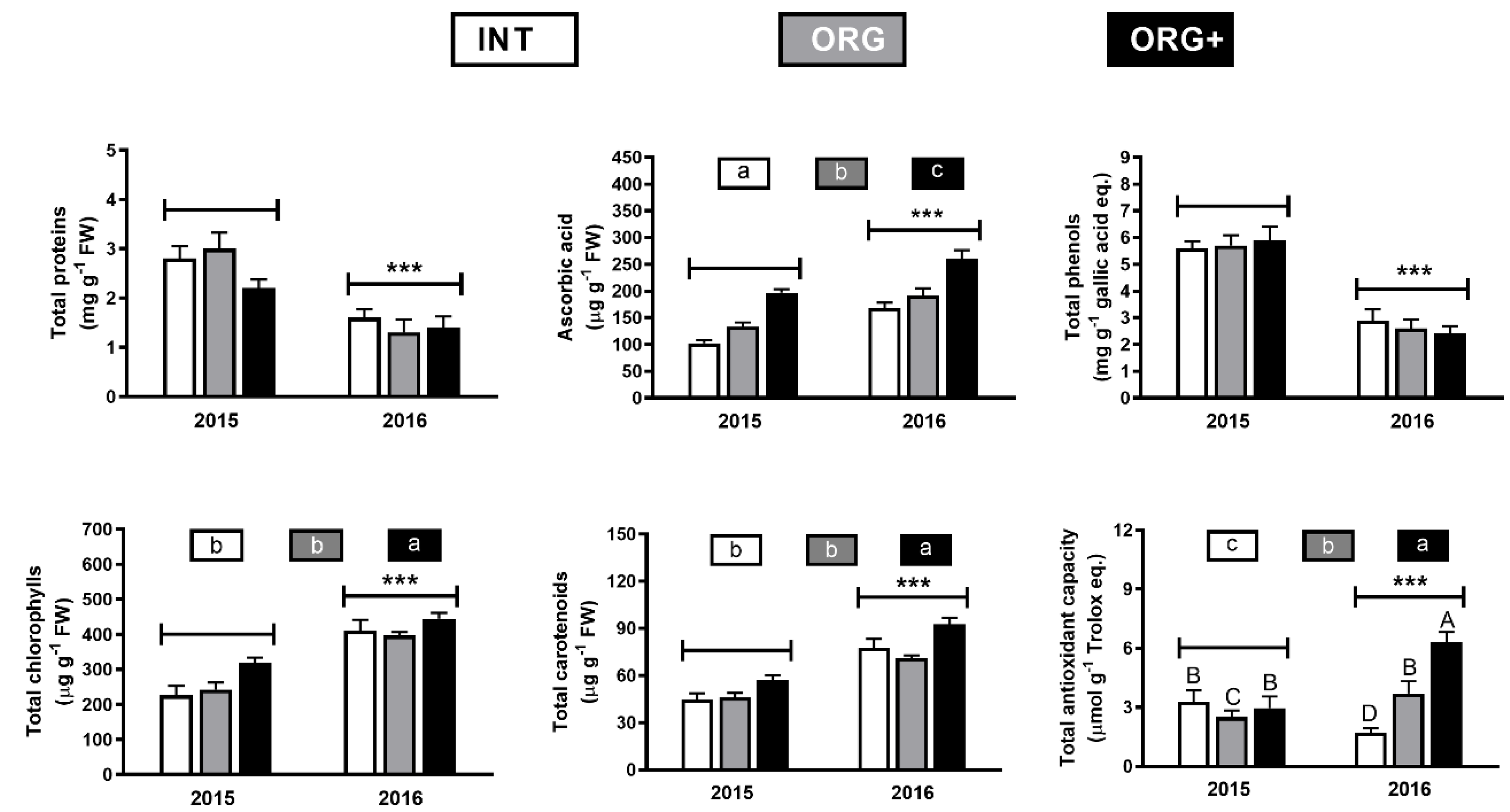

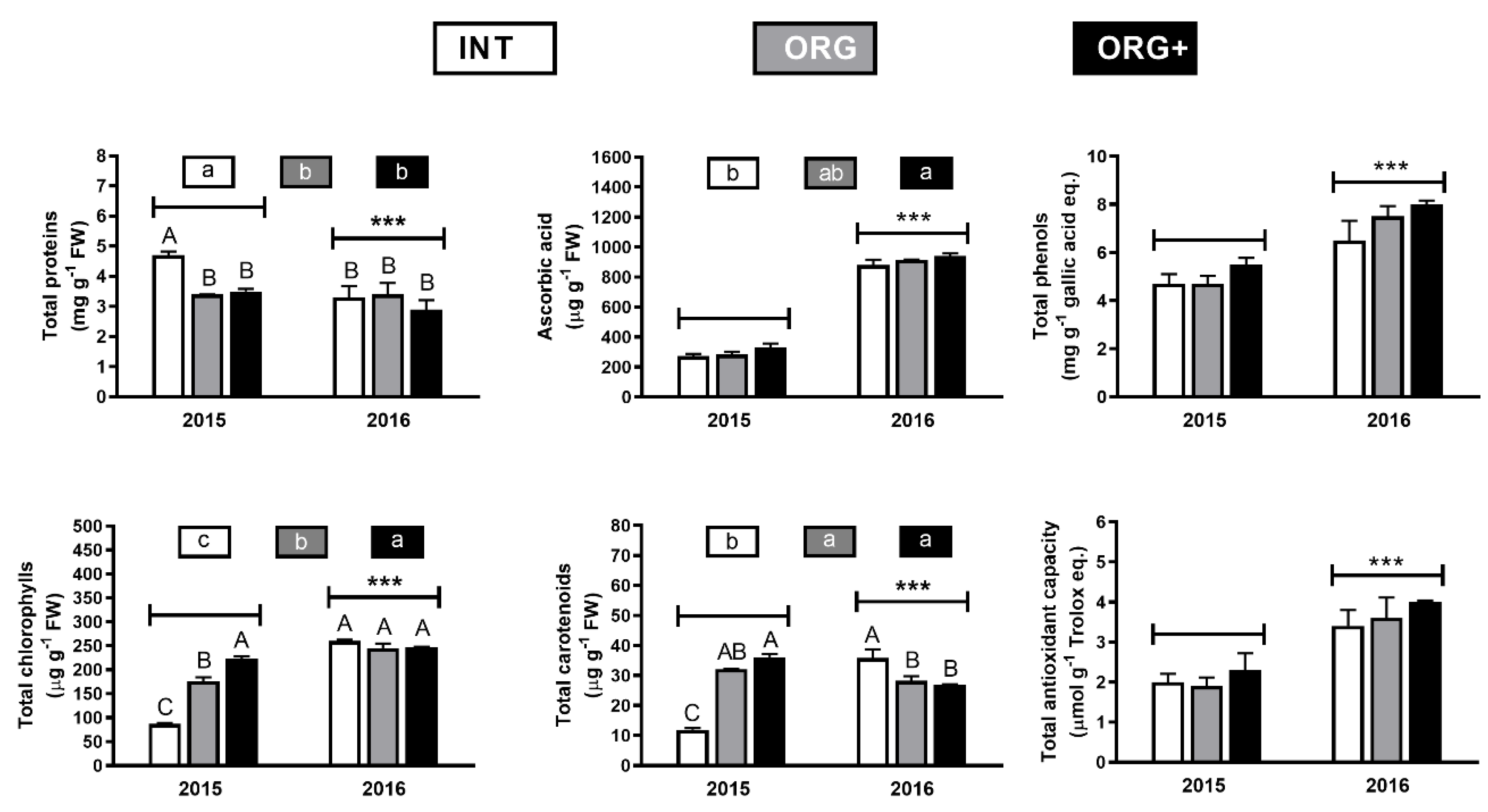
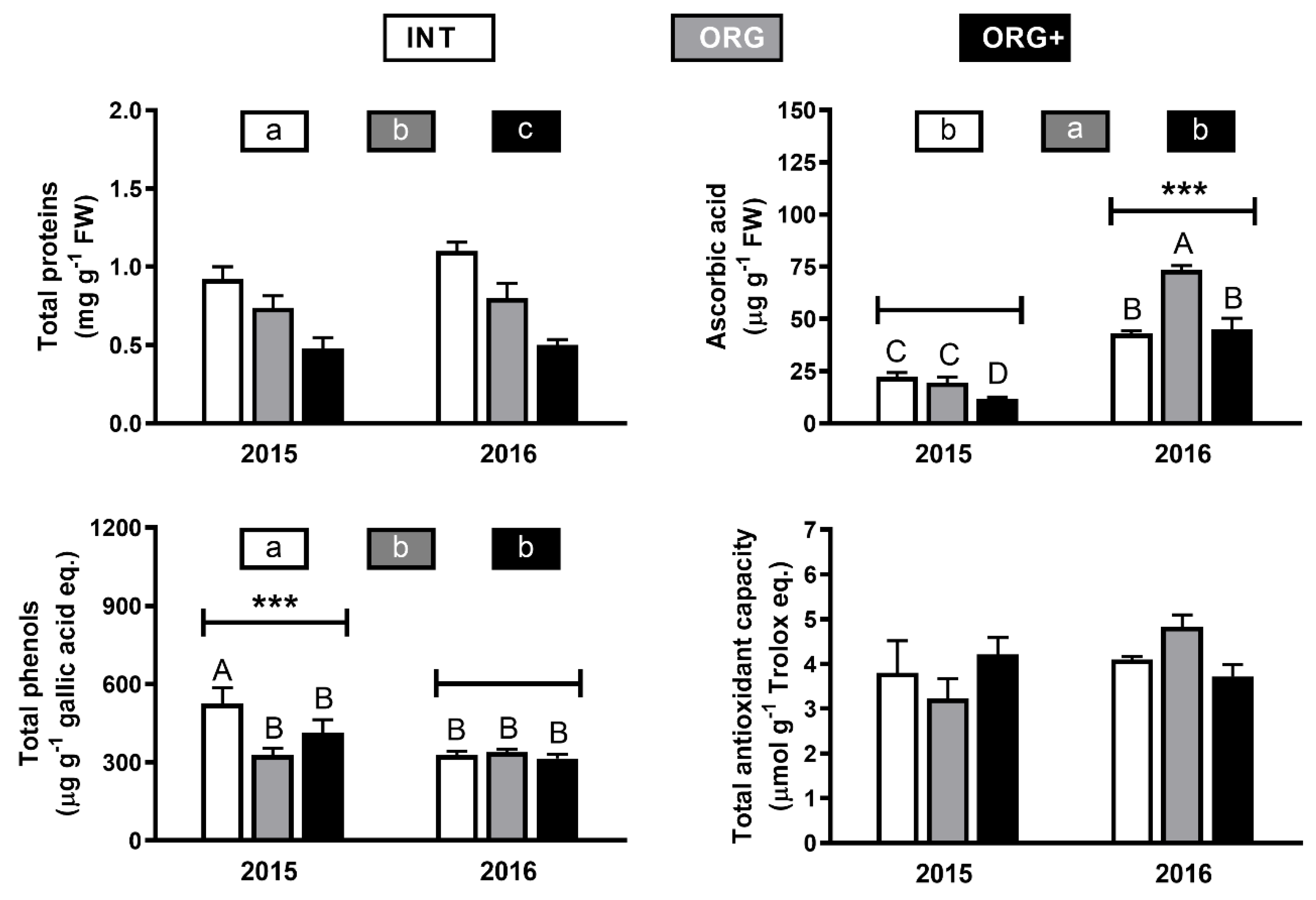
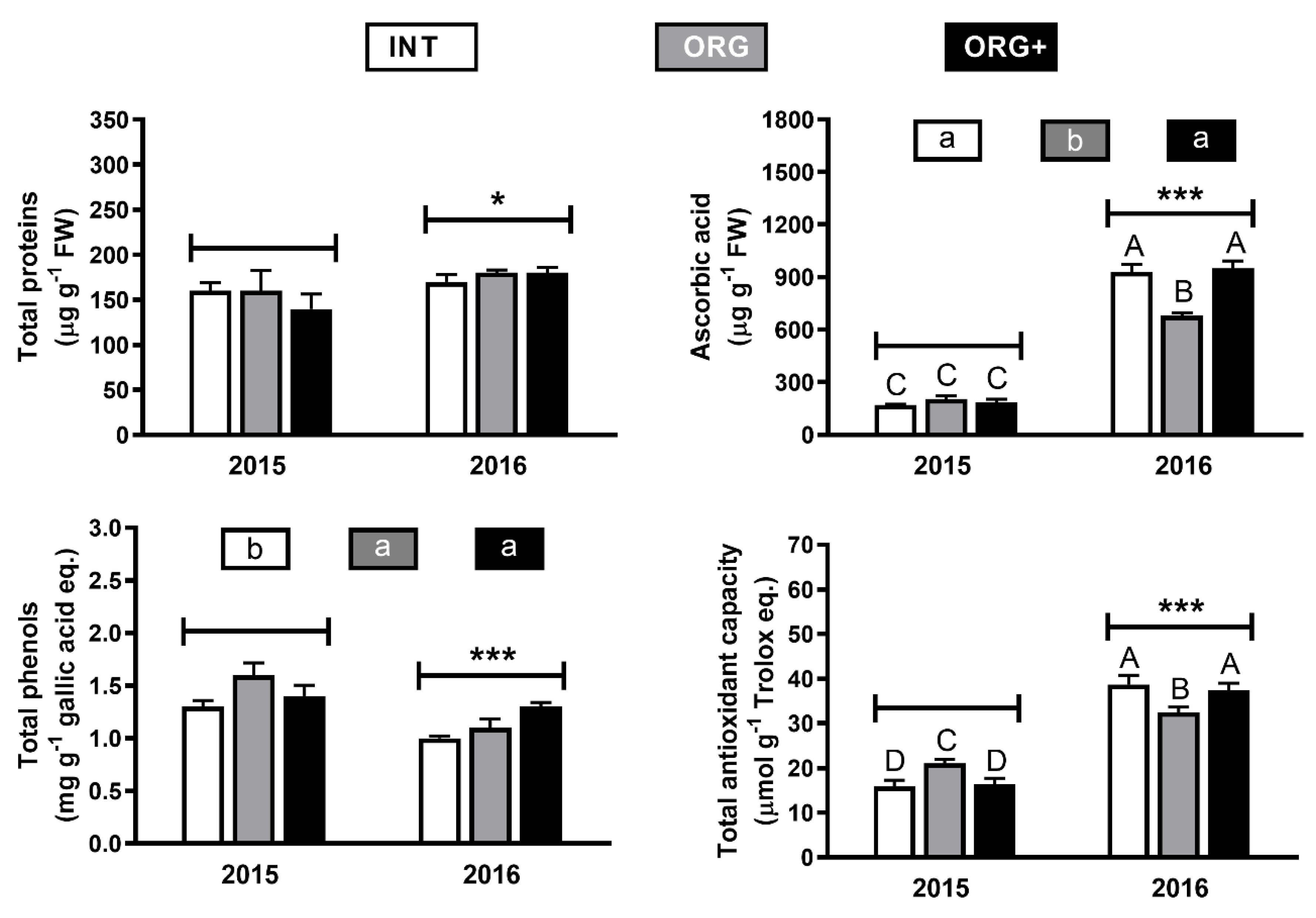

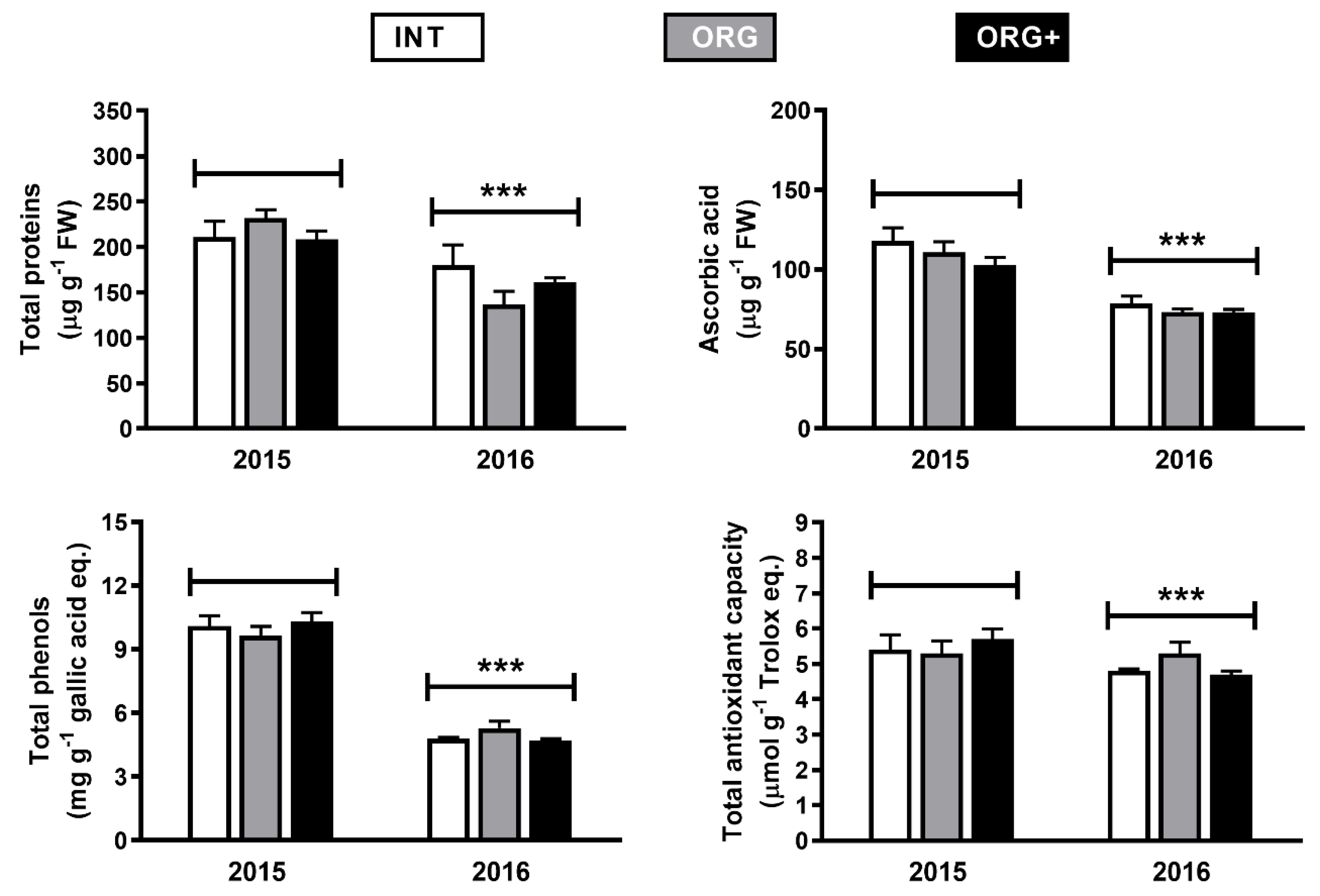

| Crop | Level | Main Tillage | Cover Cropping | Crop Establishment | Weed | Pest |
|---|---|---|---|---|---|---|
| Eggplant | INT 1 | Spading | None | Transplanting | Chemical 2 and mechanical weeding | Chemical 4 |
| ORG 1 | Spading | Green manure, incorporated | Transplanting | Mechanical weeding | ||
| ORG+ 1 | No-till | Cover crop, roll-crimped | No-till transplanting | Flame weeding | ||
| Apple | INT | Disk harrowing | None | Chemical 3 and mechanical weeding | Chemical 4 | |
| ORG | Disk harrowing | Green manure, incorporated | Flame weeding on the row | |||
| ORG+ | No-till | Permanent cover crop | Mowing |
| Crop | Level | Fertilizer | Dosage (kg h–1) |
|---|---|---|---|
| Eggplant | INT | Bovine manure 1 | 70 |
| CH4N2O | 200 | ||
| ORG | Manure 1 | 70 | |
| NPK 2 fertilizer | 600 | ||
| ORG+ | Bovinemanure 1 | 70 | |
| NPK fertilizer | 600 | ||
| Apple | INT | None | - |
| ORG | None | - | |
| ORG+ | None | - |
| Crop | Level | Crop Rotation | Green Manure and Cover Crop Species |
|---|---|---|---|
| Spring lettuce | INT | Spring lettuce–Fennel–Summer lettuce–Savoy cabbage | None |
| ORG | Spring lettuce–Summer green manure–Spring green manure–Summer lettuce–Savoy cabbage | None | |
| ORG+ | Spring lettuce–Summer cover crops–Fennel–Savoy cabbage | None | |
| Summer lettuce | INT | Spring lettuce–Fennel–Summer lettuce–Savoy cabbage | None |
| ORG | Spring lettuce–Summer green manure–Spring green manure–Summer lettuce–Savoy cabbage | None | |
| ORG+ | Summer lettuce–Summer cover crops–Fennel–Savoy cabbage | Trifolium pratense L | |
| Savoy cabbage | INT | Spring lettuce–Fennel–Summer lettuce–Savoy cabbage | None |
| ORG | Spring lettuce–Summer green manure–Spring green manure–Summer lettuce–Savoy cabbage | Vicia faba var. minor Beck + Pisum sativum L. | |
| ORG+ | Spring lettuce–Summer cover crops–Fennel–Savoy cabbage | Trifolium pratense L. | |
| Fennel | INT | Spring lettuce–Fennel–Summer lettuce–Savoy cabbage | None |
| ORG | Spring lettuce–Summer green manure–Spring green manure–Summer lettuce–Savoy cabbage | Fagopyrum esculentum Moench + Panicum miliaceum L. + Setaria italica (L.) Beauv + Vigna unguiculata (L.) Walp. | |
| ORG+ | Spring lettuce–Summer cover crops–Fennel–Savoy cabbage | Fagopyrum esculentum Moench + Panicum miliaceum L. + Setaria italica (L.) Beauv + Vigna unguiculata (L.) Walp. | |
| Processing tomato | INT | Durum Wheat–Processing tomato | None |
| ORG | Durum wheat–Spring green manure–Processing tomato | P. arvense L. + Hordeum vulgare L. | |
| ORG+ | Durum wheat/Pigeon bean intercropping–Cover crops–Processing tomato | P. arvense L. + Hordeum vulgare L. | |
| Eggplant | INT | Durum wheat–Eggplant | None |
| ORG | Durum wheat–Spring green manure–Eggplant | Trifolium spp. | |
| ORG+ | Durum wheat–Cover crop–Eggplant | Trifolium spp. | |
| Apple | INT | None | |
| ORG | P. sativum + Eruca sativa Mill. + Sinapis alba L. | ||
| ORG+ | T. repens L. + Festuca rubra L. + Lolium perenne L. |
© 2020 by the authors. Licensee MDPI, Basel, Switzerland. This article is an open access article distributed under the terms and conditions of the Creative Commons Attribution (CC BY) license (http://creativecommons.org/licenses/by/4.0/).
Share and Cite
Ceccanti, C.; Landi, M.; Antichi, D.; Guidi, L.; Manfrini, L.; Monti, M.; Tosti, G.; Frasconi, C. Bioactive Properties of Fruits and Leafy Vegetables Managed with Integrated, Organic, and Organic No-Tillage Practices in the Mediterranean Area: A Two-Year Rotation Experiment. Agronomy 2020, 10, 841. https://doi.org/10.3390/agronomy10060841
Ceccanti C, Landi M, Antichi D, Guidi L, Manfrini L, Monti M, Tosti G, Frasconi C. Bioactive Properties of Fruits and Leafy Vegetables Managed with Integrated, Organic, and Organic No-Tillage Practices in the Mediterranean Area: A Two-Year Rotation Experiment. Agronomy. 2020; 10(6):841. https://doi.org/10.3390/agronomy10060841
Chicago/Turabian StyleCeccanti, Costanza, Marco Landi, Daniele Antichi, Lucia Guidi, Luigi Manfrini, Michele Monti, Giacomo Tosti, and Christian Frasconi. 2020. "Bioactive Properties of Fruits and Leafy Vegetables Managed with Integrated, Organic, and Organic No-Tillage Practices in the Mediterranean Area: A Two-Year Rotation Experiment" Agronomy 10, no. 6: 841. https://doi.org/10.3390/agronomy10060841
APA StyleCeccanti, C., Landi, M., Antichi, D., Guidi, L., Manfrini, L., Monti, M., Tosti, G., & Frasconi, C. (2020). Bioactive Properties of Fruits and Leafy Vegetables Managed with Integrated, Organic, and Organic No-Tillage Practices in the Mediterranean Area: A Two-Year Rotation Experiment. Agronomy, 10(6), 841. https://doi.org/10.3390/agronomy10060841











